The Advancement Trail
On the advancement trail, a Cub Scout progresses from rank to rank, learning new skills as he goes. Each of the ranks and awards in Cub Scouting has its own requirements. As you advance through the ranks, the requirements get more challenging, to match the new skills and abilities you learn as you get older.
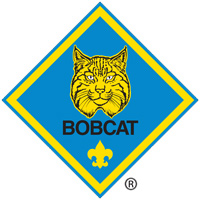
Bobcat
No matter what age or grade a boy joins Cub Scouting, he must earn his Bobcat badge before he can advance to the rank of Tiger Cub, Wolf, Bear, or Webelos. A boy must complete the Bobcat requirements, which include:
- Learn and say the Cub Scout motto, the Cub Scout Promise, and the Law of the Pack and tell what they mean;
- Show the Cub Scout sign, salute, and handshake and tell what they mean; and
- Show that you understand and believe that it is important to be honest and trustworthy.
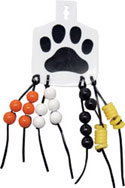
Tiger Cub
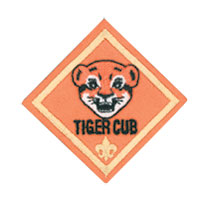
To begin his path to the Tiger Cub rank, the Tiger Cub (age 7) must learn the Cub Scout promise, the Cub Scout sign, and the Cub Scout salute. When he has learned these, he gets his Tiger Cub emblem, which is a tiger paw with four strings for beads. He wears the emblem on his right pocket.
As a boy finishes each part of the five Tiger Cub achievements, he earns an orange bead (for den activities), a white bead (for family activities), or a black bead (for "Go See Its"). When the boy has earned five beads of each color, he can receive his Tiger Cub badge. The Tiger Cub badge is given to the boy's adult partner at a pack meeting. Then, during a grand ceremony, the adult gives the badge to the boy.
Wolf

The Wolf rank is for boys who have finished first grade (or who are 8 years old). To earn the Wolf badge, a boy must pass 12 achievements. His parent or guardian approves each achievement by signing his book. When the boy has met all requirements, the Wolf badge is presented to his parent or guardian at the next pack meeting. During an impressive ceremony, the parent or guardian then presents the badge to the boy.
After he has earned the Wolf badge, a Wolf Cub Scout can work on the 23 Wolf electives until he finishes second grade (or turns 9 years old). He can choose from more than 100 elective projects that may show him new hobbies and teach him skills that will be useful during his Boy Scout years. When he completes 10 elective projects, he earns a Gold Arrow Point to wear under the Wolf badge. For each 10 elective projects after that, he earns a Silver Arrow Point.
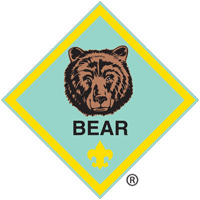
Bear
The Bear rank is for boys who have finished second grade (or are 9 years old). There are 24 Bear achievements in four groups. A boy must complete 12 of the achievements to be a Bear Cub Scout. These requirements are harder and more challenging than those for the Wolf badge. When a boy has earned his Bear badge, he may work on electives to earn Arrow Points to wear under his Bear badge.
Webelos
Webelos dens are for boys who have completed third grade (or reached age 10). The Webelos den program is different from the Cub Scout den program. Everything in the Webelos Scout program is more challenging than what younger boys in the pack do. Webelos Scouts get to work on the 20 Webelos activity badges:
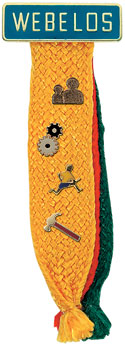
|
Physical Skills
- Aquanaut
- Athlete
- Fitness
- Sportsman
Mental Skills
- Artist
- Scholar
- Showman
- Traveler
|
Community
- Citizen
- Communicator
- Family Member
- Readyman
Technology
- Craftsman
- Engineer
- Handyman
- Scientist
|
Outdoor Activity
- Forester
- Geologist
- Naturalist
- Outdoorsman
|
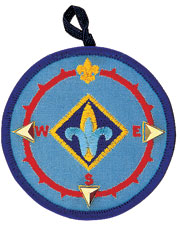
Webelos Scouts work on requirements during their weekly den meetings. Once a boy learns a skill, he practices it at den meetings and at home on his own. His family helps him at home. Webelos Scouts bring the projects they do at home to the den meetings to show others, and to have the Webelos den leader approve their projects.
When a boy has done the requirements for an activity badge, the Webelos den leader or activity badge counselor, rather than a parent, approves most of the activity badges. It takes three activity badges, including Fitness and Citizen, to earn the Webelos badge.
Besides earning activity badges, Webelos Scouts can earn the compass points emblem. This emblem is awarded after a Webelos Scout has earned seven activity badges. For each four activity badges a Webelos Scout earns after that, he receives a compass point—east, west, north, and south.
Arrow of Light

The highest rank in Cub Scouting is the Arrow of Light Award. Earning this rank prepares a Webelos Scout to become a Boy Scout. Webelos Scouts who have earned the Arrow of Light Award have also completed all requirements for the Boy Scout badge.

This award is the only Cub Scout badge that can be worn on the Boy Scout uniform when a boy graduates into a troop. Adult leaders who earned the Arrow of Light Award when they were young may also show their achievement by wearing a special square knot on their adult uniform.